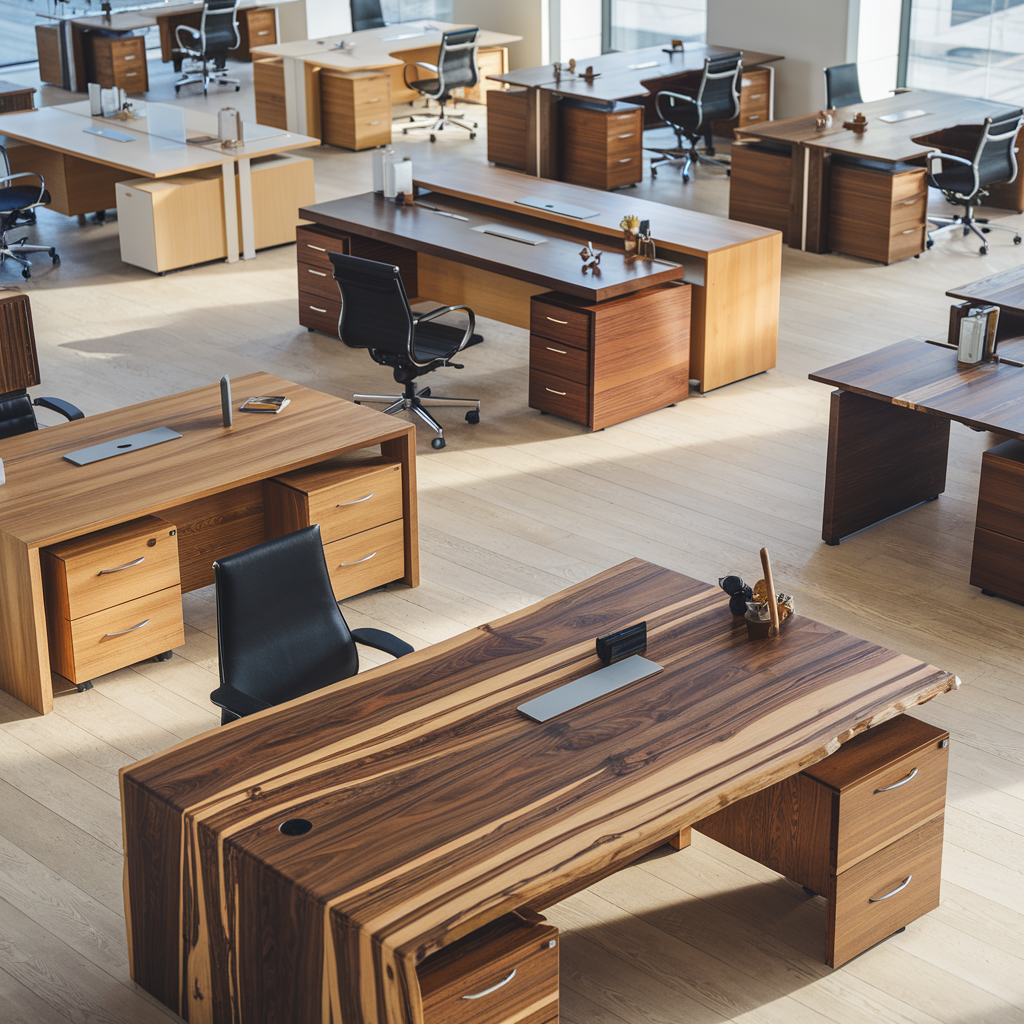Best Wood Types for Durable and Stylish Office Desks
When investing in an office desk, durability and aesthetics are key considerations especially for workspaces where furniture needs to stand the test of time. Solid wood desks are favored for their strength, timeless appeal, and ability to age gracefully. But not all wood types are created equal.
In this guide, we’ll explore the best wood types for office desks, comparing their durability, grain patterns, finishes, and suitability for different office styles and usage needs.
Why Solid Wood Desks Are Worth the Investment
Longevity and Strength
Unlike engineered wood or laminate options, solid wood desks are long-lasting. They resist wear, allow refinishing, and improve with age. With proper care, a high-quality wood desk can last decades, making it a smart long-term investment.
Aesthetic Versatility
Natural wood grain brings warmth and elegance to any space whether modern, traditional, or minimalist. From rich walnut to bright maple, wood adapts to your visual goals, adding a sense of quality and permanence to your work environment.
Sustainability
Many wood types are available with FSC certification or sourced from responsibly managed forests. Choosing sustainably sourced wood not only reduces your environmental footprint but also supports ethical forestry practices.
Explore our Desks Collection for handcrafted pieces in premium woods.
Top Wood Types for Office Desks
1. Oak
Characteristics:
- Extremely strong and dense
- Prominent, attractive grain pattern
- Available in white or red varieties
Pros:
- Resistant to scratches and dents
- Takes stains well for various finishes
- Ages beautifully with regular use
Best For:
- Traditional and rustic offices
- Executive desks with visual weight
- Offices that demand heavy daily use
2. Walnut
Characteristics:
- Rich dark brown tones
- Fine, straight grain with occasional waves
Pros:
- Luxurious look and feel
- Highly durable, resists warping
- Great for high-end professional environments
Best For:
- Contemporary and luxury office spaces
- Statement executive desks
- Creative industries or corner offices
3. Maple
Characteristics:
- Light creamy color
- Smooth and uniform grain
Pros:
- Extremely hard and long-lasting
- Stains evenly for modern looks
- Easy to maintain with minimal warping
Best For:
- Minimalist workspaces
- Shared or desk clusters environments
- Open-plan or hybrid offices
4. Cherry
Characteristics:
- Reddish hue that deepens over time
- Smooth grain with elegant warmth
Pros:
- Beautiful aging process
- Medium hardness suitable for daily use
- Adds sophistication to any workspace
Best For:
- Classic or vintage-inspired offices
- Compact desks in private rooms
- Offices emphasizing aesthetic character
5. Ash
Characteristics:
- Light color with straight grain
- Similar in durability to oak but lighter in weight
Pros:
- Affordable and sturdy
- Flexible design compatibility
- Lends brightness to small or dimly lit rooms
Best For:
- Modern, Scandinavian-inspired spaces
- Smaller or home office desks
- Budget-conscious but quality-focused users
Finishes and Protection
Natural Oil vs Polyurethane
- Natural Oil: Enhances the wood’s feel and breathability, offering a soft, matte finish
- Polyurethane: Creates a harder, protective surface for high-use environments, adds shine and moisture resistance
Choosing the right finish depends on your aesthetic preference and how heavily the desk will be used. Polyurethane is better for high-traffic areas, while natural oil is perfect for low-touch executive settings.
Regular Maintenance
Dust regularly and clean with a damp cloth. Reapply finish as needed every few years to keep wood nourished. Avoid placing hot items or liquids directly on the surface to prevent damage.
See our Wood Desk Care Guide for more maintenance tips.
Matching Wood Types with Office Aesthetics
Traditional Offices
- Choose darker woods like walnut or cherry
- Pair with rich filing cabinets and leather chairs
- Add classic décor for a cohesive professional environment
Modern Offices
- Opt for maple, ash, or white oak
- Complement with clean lines, light finishes, and wall shelves
- Use subtle contrast in materials and accessories
Open Plan or Collaborative Workspaces
- Use light woods to keep the space bright and open
- Combine with modular desk clusters
- Incorporate plants and natural lighting to soften large work zones
Explore More on Office Furniture Materials
For deeper insights into desk choices, layout trends, and workspace materials, browse our curated blog categories:
These resources provide practical tips on selecting furniture that enhances productivity, style, and longevity.
Final Thoughts
Your choice of wood has a lasting impact on the functionality, feel, and style of your office. Oak and walnut offer strength and sophistication, while maple and ash keep things light and modern. Cherry adds warmth and elegance for timeless appeal.
At Pnstime.com, we use only high-quality, sustainably sourced wood in our office furniture. Whether you’re designing an executive suite, shared workspace, or minimalist home office.

